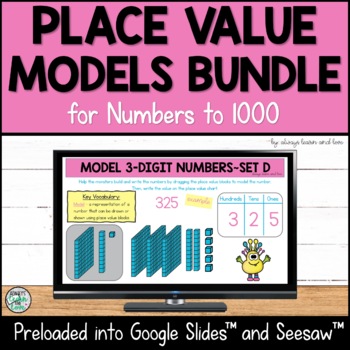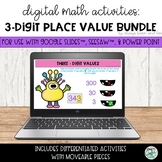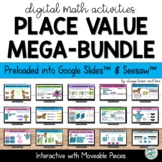Place Value Models for Numbers to 1000 Bundle for Google Slides™ and Seesaw™
- Zip
- Google Apps™

Also included in
- This is a collection of digital math activities pre-loaded and ready to use with Seesaw™ and Google™ for 2nd grade number sense skills ideal for Distance Learning and Homeschool. Students learn and practice 3-digit numbers with digit value, expanded form, decomposing numbers, writing 3-digit numbePrice $24.29Original Price $30.33Save $6.04
- This collection of numbers to 100 and numbers to 1000 digital math activities is pre-loaded and ready to use with Seesaw™ and Google Slides™ for 1st grade and 2nd grade students for number sense skills ideal for Distance Learning and Homeschool. Students learn and practice 2-digit and 3-digit numbPrice $65.79Original Price $85.26Save $19.47
Description
Teaching 3-digit numbers with limited manipulatives? These no-prep, interactive digital math activities and task cards are differentiated and cover building models of numbers to 1000 and grouping tens as hundreds using moveable place value blocks. Pre-loaded and ready to use with Seesaw™ and Google Slides™, these digital assignments are easy to assign, and are ideal for math centers, warm-ups, homework, independent work, modeling, intervention, review, enrichment, and all types of academic settings such as Virtual Learning, In-Person, Asynchronous and Synchronous Learning, and Homeschool.
This Product is Part of the Numbers to 1000 Bundle available HERE. Save $$$ by purchasing the Bundle.
About the Activities:
Place Value Models of Numbers to 1000
- 4 different activities
- a total of 80 slides
- Instructional and example slides for each activity
- Differentiated in 4 sets:
- Set A: Numbers 0-300
- Set B: Numbers 301-600
- Set C: Numbers 601-999
- Set D: Mixture of Numbers 0-999
- Interactive with moveable place value model pieces
- Scaffolded for students who need more support
Grouping Place Value Models of Numbers to 1000
- 2 different activities
- a total of 40 slides
- Instructional and example slides for each activity
- Differentiated in 2 sets:
- Group Tens as Hundreds: circle tens to make a hundred and write in multiple ways
- Group Tens as Hundreds and Count: circle tens to make a hundred and count extra tens before writing in multiple ways
- Interactive with moveable place value model pieces
- Scaffolded for students who need more support
Examples of How to Use this Activity:
- Assign in Seesaw™ or Google Slides™
- Assign as center work during class time
- Model by sharing the teacher screen
- Use with a smart board
- Project for the class to complete together
- Assign as independent work or partner work
Formats:
Each activity comes in all 3 formats listed below and can easily be uploaded to Microsoft or Nearpod.
Seesaw™: Click on the link provided in the pdf and the activity will automatically download to your Seesaw™ Activity Library with all icons, shortcuts, digital manipulatives, and directions included.
Google Classroom™: Click on the link provided in the pdf and a copy of the activity will automatically download to your Google Slides™ account where it can be assigned to students. All moveable pieces and text boxes are pre-loaded and ready for use.
PowerPoint™: There is a file for you to open, use, and easily upload to Microsoft or Nearpod. Digital manipulatives are pre-loaded and ready to use.
You May Also Like:
US Money Counting Coins for Google Slides™ Seesaw™
US Money Coin Identification and Coin Sorting for Google Slides™ Seesaw™
2-Digit Addition Without Regrouping Bundle
Numbers to 1000 Place Value Bundle
Numbers to 100 Place Value Bundle
* Click HERE to follow my store. You will receive notification when new resources are added to my store and when there is a sale.
*This purchase is for SINGLE CLASSROOM USE ONLY. To share with other teachers or teammates, an additional license will need to be purchased. If you have any questions, please contact me at alwayslearnandlove@gmail.com.
* Click HERE to leave feedback on a resources and receive TpT credit towards future purchases.
Thanks,
Kim Naiman







